
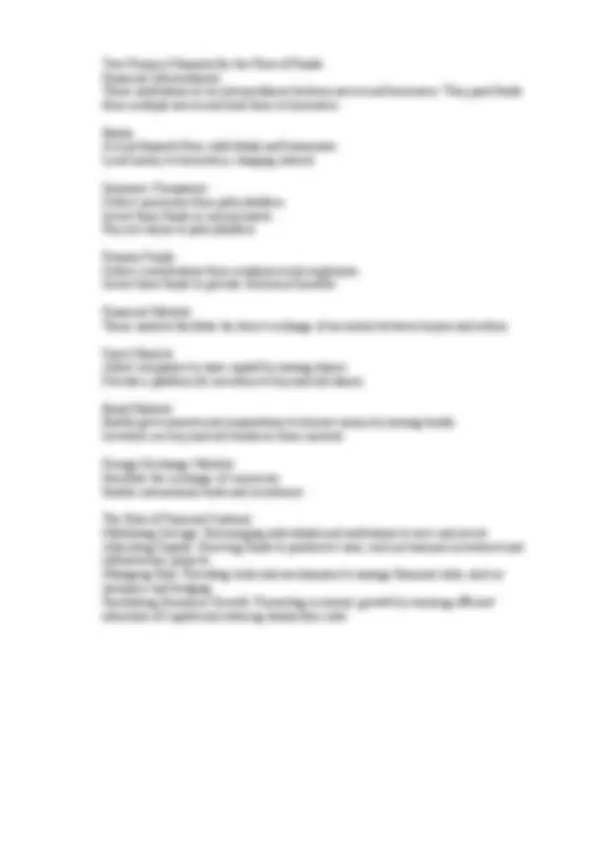
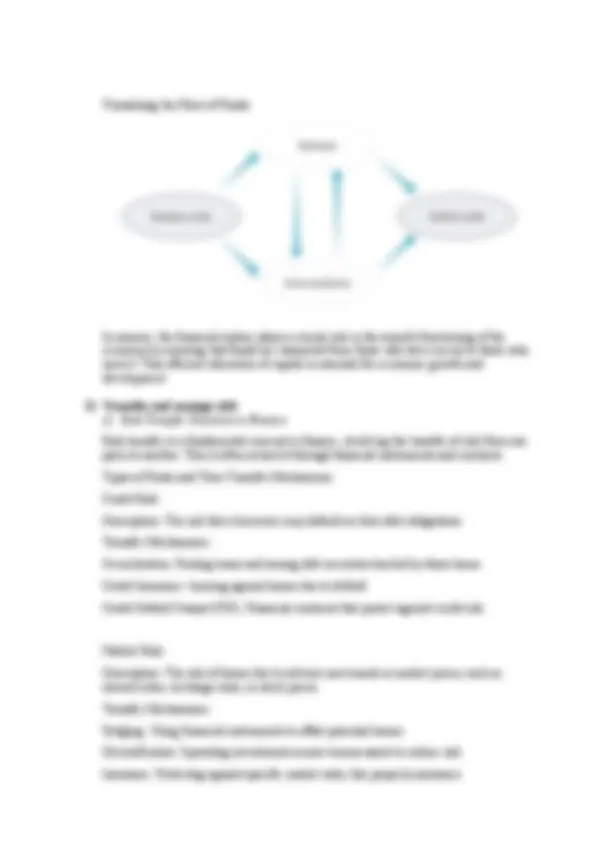
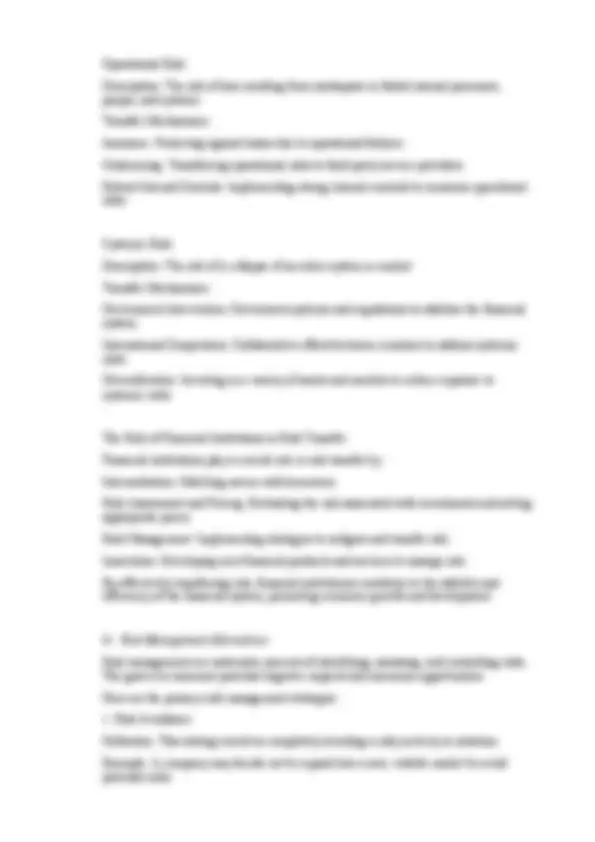
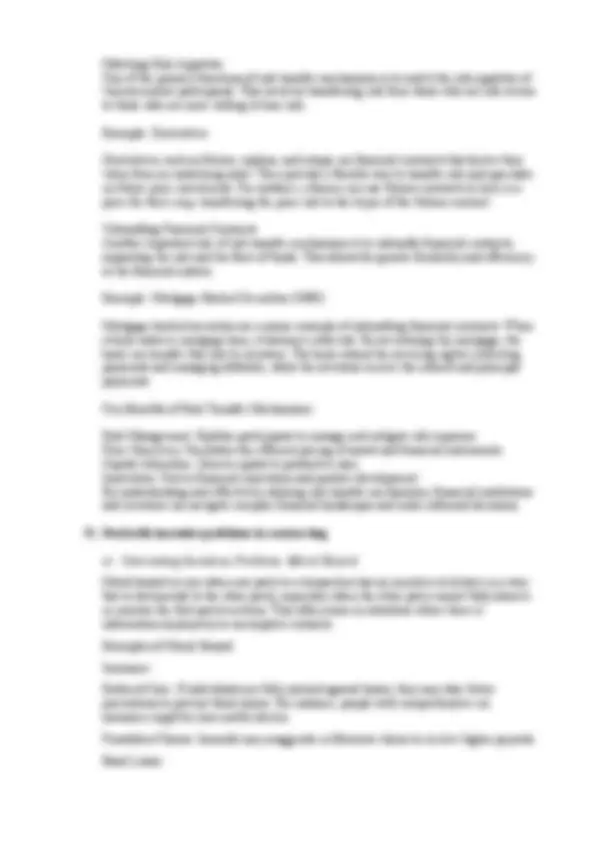
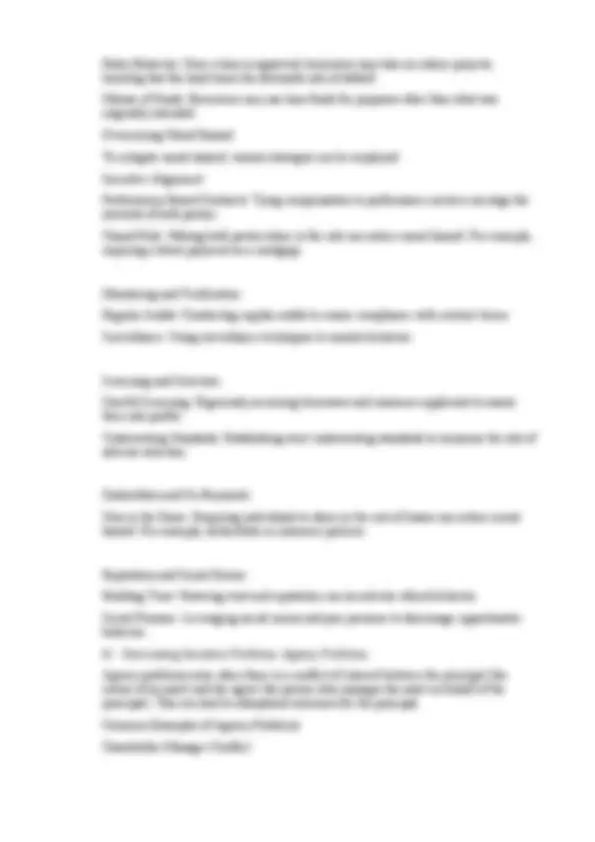
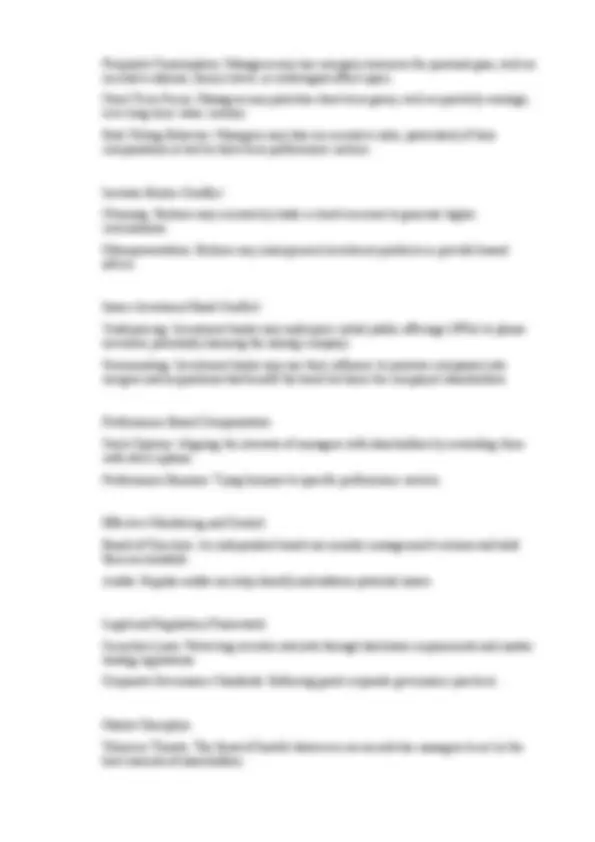


Study with the several resources on Docsity

Earn points by helping other students or get them with a premium plan


Prepare for your exams
Study with the several resources on Docsity

Earn points to download
Earn points by helping other students or get them with a premium plan
Community
Ask the community for help and clear up your study doubts
Discover the best universities in your country according to Docsity users
Free resources
Download our free guides on studying techniques, anxiety management strategies, and thesis advice from Docsity tutors
This document delves into the crucial role of risk transfer mechanisms in the financial system. It explains how these mechanisms, such as derivatives and mortgage-backed securities, enable participants to manage and allocate risk effectively. The document highlights the importance of matching risk appetites and unbundling financial contracts, contributing to a more efficient and resilient financial system. It also discusses the benefits of risk transfer mechanisms, including risk management, price discovery, and innovation.
Typology: Assignments
1 / 12

This page cannot be seen from the preview
Don't miss anything!







Formative assessment 1 NĂM HỌC/ ACADEMIC YEAR:2024- 2025 MÔN/ SUBJECT: Business Finance Họ và tên/ Student name: Dao Thuy Trang MSSV/ Student ID : 2205000233 Ngày thi/ Exam date : 30/10/ Lớp/ Class :FUONM 7 D Thời gian làm bài/ Duration : 30 phút/ minutes ( bao gồm thời gian đọc đề / including the reading time) PHẦN I/ PART I : (4 MARKS) What are the functions of the financial system? Explain and provide examples?
Description: Financial instruments whose value is derived from an underlying asset. Settlement: Cash Settlement: The difference between the contract price and the market price at expiration is paid in cash. Physical Settlement: The underlying asset is delivered. Fixed-Income Securities: Description: Debt instruments, such as bonds and notes. Settlement: Typically settled through a clearinghouse, similar to equities. Foreign Exchange: Description: The buying and selling of currencies. Settlement: Usually settled through a payment system, such as SWIFT, which facilitates the transfer of funds between banks. Settlement Process: A Simplified Example Trade Execution: A buyer and seller agree on the terms of a trade, such as the price and quantity. Clearing: The trade is sent to a clearinghouse, which verifies the trade and assigns a settlement date. Settlement: Funds Transfer: The buyer's broker transfers funds to the seller's broker. Asset Delivery: The seller's broker delivers the securities to the buyer's broker. Important Considerations in Settlement: Timing: Settlement cycles can vary, but they typically occur within a few business days. Risk Management: Clearinghouses mitigate counterparty risk by acting as intermediaries and ensuring that transactions are completed. Regulatory Framework: Financial regulations govern the settlement process to ensure market integrity and investor protection. By understanding the settlement process and the role of financial contracts, investors and businesses can make informed decisions and manage their financial risks effectively. b) Settle of transaction Transaction: arrangement between a buyer and a seller to exchange an asset or service for payment Settlement is when value (=purchasing power) and title transfer Transaction and settlement can be different (example: payment by cheque) Organised network of connections: the payment system 2) Arrange the flow of funds (that is, financing) The financial system serves as a vital conduit for the efficient allocation of capital, connecting individuals and institutions with surplus funds (investors or depositors) to those in need of financing (deficit units).
Visualizing the Flow of Funds: In essence, the financial system plays a crucial role in the smooth functioning of the economy by ensuring that funds are channeled from those who have excess to those who need it. This efficient allocation of capital is essential for economic growth and development. 3) Transfer and manage risk a) Risk Transfer Function in Finance Risk transfer is a fundamental concept in finance, involving the transfer of risk from one party to another. This is often achieved through financial instruments and contracts. Types of Risks and Their Transfer Mechanisms Credit Risk: Description: The risk that a borrower may default on their debt obligations. Transfer Mechanisms: Securitization: Pooling loans and issuing debt securities backed by those loans. Credit Insurance: Insuring against losses due to default. Credit Default Swaps (CDS): Financial contracts that protect against credit risk. Market Risk: Description: The risk of losses due to adverse movements in market prices, such as interest rates, exchange rates, or stock prices. Transfer Mechanisms: Hedging: Using financial instruments to offset potential losses. Diversification: Spreading investments across various assets to reduce risk. Insurance: Protecting against specific market risks, like property insurance.
Operational Risk: Description: The risk of loss resulting from inadequate or failed internal processes, people, and systems. Transfer Mechanisms: Insurance: Protecting against losses due to operational failures. Outsourcing: Transferring operational risks to third-party service providers. Robust Internal Controls: Implementing strong internal controls to minimize operational risks. Systemic Risk: Description: The risk of a collapse of an entire system or market. Transfer Mechanisms: Government Intervention: Government policies and regulations to stabilize the financial system. International Cooperation: Collaborative efforts between countries to address systemic risks. Diversification: Investing in a variety of assets and markets to reduce exposure to systemic risks. The Role of Financial Institutions in Risk Transfer Financial institutions play a crucial role in risk transfer by: Intermediation: Matching savers with borrowers. Risk Assessment and Pricing: Evaluating the risk associated with investments and setting appropriate prices. Risk Management: Implementing strategies to mitigate and transfer risk. Innovation: Developing new financial products and services to manage risk. By effectively transferring risk, financial institutions contribute to the stability and efficiency of the financial system, promoting economic growth and development. b) Risk Management Alternatives Risk management is a systematic process of identifying, assessing, and controlling risks. The goal is to minimize potential negative impacts and maximize opportunities. Here are the primary risk management strategies:
One of the primary functions of risk transfer mechanisms is to match the risk appetites of various market participants. This involves transferring risk from those who are risk-averse to those who are more willing to bear risk. Example: Derivatives Derivatives, such as futures, options, and swaps, are financial contracts that derive their value from an underlying asset. They provide a flexible way to transfer risk and speculate on future price movements. For instance, a farmer can use futures contracts to lock in a price for their crop, transferring the price risk to the buyer of the futures contract. Unbundling Financial Contracts Another important role of risk transfer mechanisms is to unbundle financial contracts, separating the risk and the flow of funds. This allows for greater flexibility and efficiency in the financial system. Example: Mortgage-Backed Securities (MBS) Mortgage-backed securities are a prime example of unbundling financial contracts. When a bank makes a mortgage loan, it assumes credit risk. By securitizing the mortgage, the bank can transfer this risk to investors. The bank retains the servicing rights (collecting payments and managing defaults), while the investors receive the interest and principal payments. Key Benefits of Risk Transfer Mechanisms: Risk Management: Enables participants to manage and mitigate risk exposure. Price Discovery: Facilitates the efficient pricing of assets and financial instruments. Capital Allocation: Directs capital to productive uses. Innovation: Drives financial innovation and product development. By understanding and effectively utilizing risk transfer mechanisms, financial institutions and investors can navigate complex financial landscapes and make informed decisions. 4) Risk Transfer Mechanisms: Matching Risk Appetites and Unbundling Contracts Risk transfer mechanisms are essential tools in the financial system, enabling participants to manage and allocate risk effectively. By matching the risk appetites of different market participants and unbundling financial contracts, these mechanisms contribute to a more efficient and resilient financial system.
Matching Risk Appetites One of the primary functions of risk transfer mechanisms is to match the risk appetites of various market participants. This involves transferring risk from those who are risk-averse to those who are more willing to bear risk. Example: Derivatives Derivatives, such as futures, options, and swaps, are financial contracts that derive their value from an underlying asset. They provide a flexible way to transfer risk and speculate on future price movements. For instance, a farmer can use futures contracts to lock in a price for their crop, transferring the price risk to the buyer of the futures contract. Unbundling Financial Contracts Another important role of risk transfer mechanisms is to unbundle financial contracts, separating the risk and the flow of funds. This allows for greater flexibility and efficiency in the financial system. Example: Mortgage-Backed Securities (MBS) Mortgage-backed securities are a prime example of unbundling financial contracts. When a bank makes a mortgage loan, it assumes credit risk. By securitizing the mortgage, the bank can transfer this risk to investors. The bank retains the servicing rights (collecting payments and managing defaults), while the investors receive the interest and principal payments. Key Benefits of Risk Transfer Mechanisms: Risk Management: Enables participants to manage and mitigate risk exposure. Price Discovery: Facilitates the efficient pricing of assets and financial instruments. Capital Allocation: Directs capital to productive uses. Innovation: Drives financial innovation and product development. By understanding and effectively utilizing risk transfer mechanisms, financial institutions and investors can navigate complex financial landscapes and make informed decisions. 5) Deal with incentive problems in contracting a) Overcoming Incentives Problems: Moral Hazard Moral hazard occurs when one party to a transaction has an incentive to behave in a way that is detrimental to the other party, especially when the other party cannot fully observe or monitor the first party's actions. This often arises in situations where there is information asymmetry or incomplete contracts. Examples of Moral Hazard Insurance: Reduced Care: If individuals are fully insured against losses, they may take fewer precautions to prevent those losses. For instance, people with comprehensive car insurance might be less careful drivers. Fraudulent Claims: Insureds may exaggerate or fabricate claims to receive higher payouts. Bank Loans:
Perquisite Consumption: Managers may use company resources for personal gain, such as excessive salaries, luxury travel, or extravagant office space. Short-Term Focus: Managers may prioritize short-term gains, such as quarterly earnings, over long-term value creation. Risk-Taking Behavior: Managers may take on excessive risks, particularly if their compensation is tied to short-term performance metrics. Investor-Broker Conflict: Churning: Brokers may excessively trade a client's account to generate higher commissions. Misrepresentation: Brokers may misrepresent investment products or provide biased advice. Issuer-Investment Bank Conflict: Underpricing: Investment banks may underprice initial public offerings (IPOs) to please investors, potentially harming the issuing company. Greenmailing: Investment banks may use their influence to pressure companies into mergers and acquisitions that benefit the bank but harm the company's shareholders. Performance-Based Compensation: Stock Options: Aligning the interests of managers with shareholders by rewarding them with stock options. Performance Bonuses: Tying bonuses to specific performance metrics. Effective Monitoring and Control: Board of Directors: An independent board can monitor management's actions and hold them accountable. Audits: Regular audits can help identify and address potential issues. Legal and Regulatory Framework: Securities Laws: Protecting investor interests through disclosure requirements and insider trading regulations. Corporate Governance Standards: Enforcing good corporate governance practices. Market Discipline: Takeover Threats: The threat of hostile takeovers can incentivize managers to act in the best interests of shareholders.
Active Shareholders: Activist investors can pressure management to improve performance. 6). Pooling of funds a) Timing Mismatch: Surplus Units: Investors may prefer immediate liquidity or long-term investments. Deficit Units: Borrowers may need funds immediately for short-term needs or long- term projects. b) Amount Mismatch: Surplus Units: Individuals may have small amounts to save, while businesses may need significant capital. Deficit Units: Borrowers may require large sums for major investments, while some individuals may need smaller loans. Role of Financial Intermediaries and Markets: Financial intermediaries and markets play a crucial role in bridging these gaps: Intermediation: Pooling Funds: Financial institutions like banks pool small savings from many individuals to form larger loan amounts. Maturity Transformation: They transform short-term liabilities (deposits) into long- term assets (loans). Market Mechanisms: Securitization: Financial instruments like bonds and stocks allow for the division of large investments into smaller units, making them accessible to a wider range of investors. Financial Markets: Stock and bond markets provide platforms for trading securities, enabling efficient allocation of capital. PHẦN II/ PART II (3 MARKS) Suppose the interest rate is 10%. What is the present value of your installments if you save $1,000 each year for: (a) 35 years (b) forever? (a) 35 years PV = 1,000x 1-( 1+0,1)-^35 0 , ~ 9,64 $ the present value of your installments if you save $1,000 each year for 35 years is $9, (b) forever PV = C r